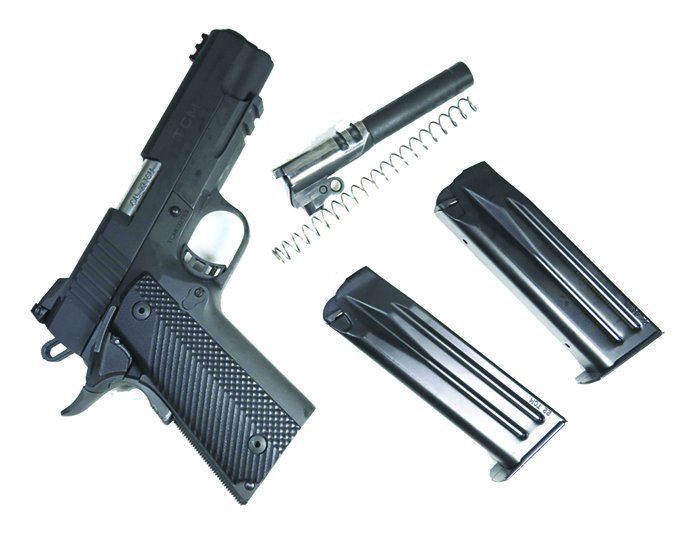
We wanted to take a look at pistols that are capable of centerfire-caliber conversions. A pistol with the ability to train in a more affordable caliber, or have the ability to increase power, speaks to our practical side since multiple pistols in multiple calibers can be expensive. We also like that a shooter is essentially using the same grip, sights, and trigger, so he doesn’t have to adapt to a pistol with different grip angle, sights, or trigger weight and pull.
We also think having a pistol that can adapt to different calibers means ammo is easier to find for your pistol. With these thoughts in mind, we acquired a SIG Sauer P226 Nitron in 9mm ($1087) and a Caliber X-Change Kit in 357 SIG ($370). The total setup cost $1457. If you own a pistol capable of caliber conversion, then you just need to opt for the caliber-conversion components.
The total for the 40 S&W Glock G35 Gen3 ($560), Glockstore.com,Double Diamond 9mm conversion barrel ($160) and Magpul 27-round magazine ($22) set us back $742. The Rock Island Armory (RIA) TCM TAC Ultra MS HC comes from the factory capable of firing both 9mm and the hot-rod 22 TCM round; total cost is $960.
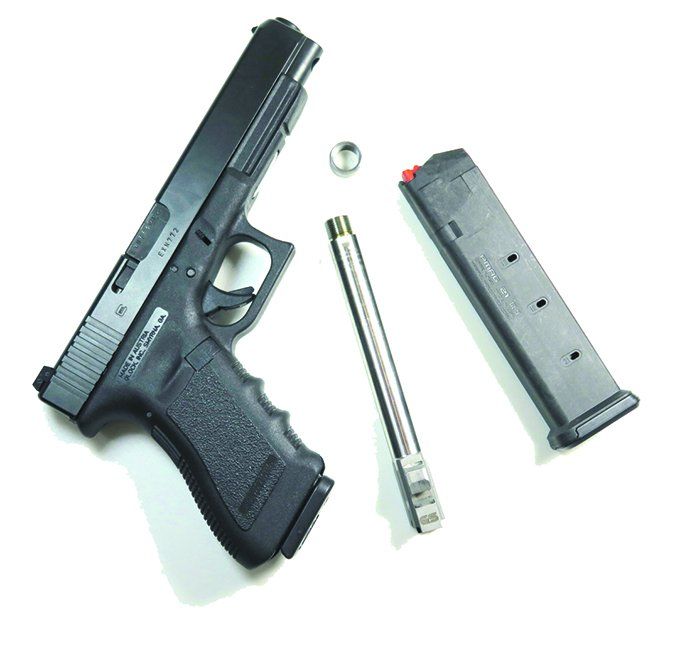
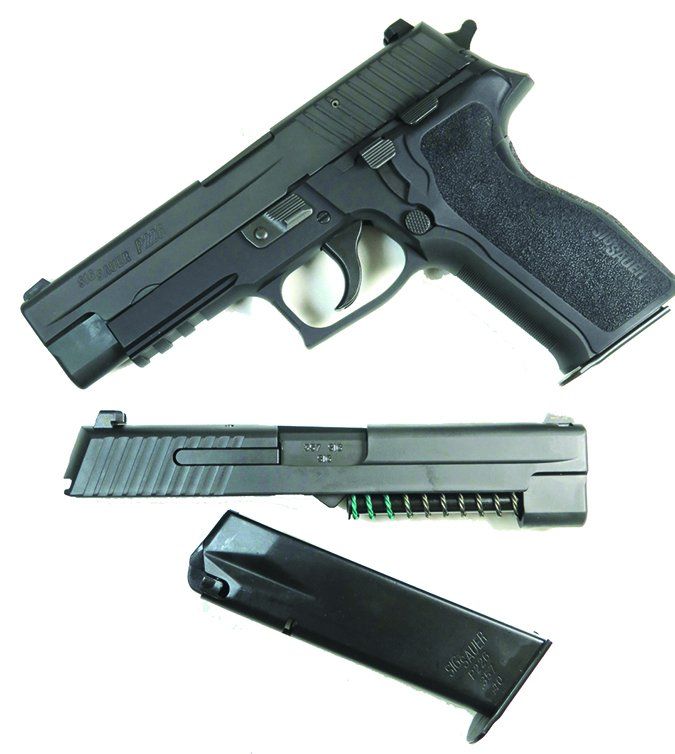
Part of our evaluation was to also see how difficult it was to convert between calibers, and we found it was as easy as field-stripping the pistol and dropping in replacement parts. Across the board, we found that no gunsmithing expertise was required, and you can swap back to the factory caliber easily.
Range Data
| GLOCK G35 40 S&W FACTORY CONFIGURATION | Winchester White Box 180-gr. FMJ | Handload 155-gr. JHP |
| Average velocity | 1072 fps | 1154 fps |
| Muzzle energy | 459 ft.-lbs. | 458 ft.-lbs. |
| Smallest group | 2.3 in. | 2.2 in. |
| Average group | 2.55 in. | 2.45 in. |
| GLOCK G35 9MM LUGER DOUBLE DIAMOND BARREL | Armscor 124-gr. FMJ | Hornady AG 115-gr. XTP |
| Average velocity | 1150 fps | 1163 fps |
| Muzzle energy | 364 ft.-lbs. | 345 ft.-lbs. |
| Smallest group | 2.4 in. | 2.09 in. |
| Average group | 2.62 in. | 2.61 in. |
| SIG P226 9MM LUGER FACTORY CONFIGURATION | Armscor 124-gr. FMJ | Hornady AG 115-gr. XTP |
| Average velocity | 1096 fps | 1116 fps |
| Muzzle energy | 331 ft.-lbs. | 318 ft.-lbs. |
| Smallest group | 1.45 in. | 1.6 in. |
| Average group | 1.72 in. | 1.75 in. |
| SIG P226 357 SIG CONVERSION KIT | Federal American Eagle 125-gr. FMJ | Federal Premium PD 125-gr. JHP |
| Average velocity | 1350 fps | 1349 fps |
| Muzzle energy | 312 ft.-lbs. | 301 ft.-lbs. |
| Smallest group | 1.3 in. | 1.32 in. |
| Average group | 2.3 in. | 1.85 in. |
| RIA TCM TAC 9MM LUGER FACTORY CONFIGURATION | Armscor 124-gr. FMJ | Hornady AG 115-gr. XTP |
| Average velocity | 1065 fps | 1085 fps |
| Muzzle energy | 312 ft.-lbs. | 301 ft.-lbs. |
| Smallest group | 1.3 in. | 1.32 in. |
| Average group | 1.95 in. | 1.49 in. |
| RIA TCM TAC 22 TCM FACTORY CONVERSION | Armscor 40-gr. JHP |
|
| Average velocity | 1924 fps | |
| Muzzle energy | 329 ft.-lbs. | |
| Smallest group | 1.9in. | |
| Average group | 2 in. | |
| To collect accuracy data, we fired five-shot groups from a bench using a rest. Distance: 25 yards with open sights. We recorded velocities using a ProChrono digital chronograph with the first screen set 10 feet from the muzzle. Ammo sources: Armscor USA 22 TCM 40-Grain JHP F AC 22TCM-1N ($19.41/50 from CheaperThanDirt.com); Armscor Ammunition 9mm Luger 124-Grain Full Metal Jacket FAC9-4 ($10.50/50 from SelwayArmory.com); Hornady American Gunner 9mm Luger 115-Grain XTP Jacketed Hollow Point 90244 ($16.50/25 from MidwayUSA.com); Federal Premium Personal Defense 357 SIG 125-Grain Jacketed Hollow Point P357S1 (50) ($60/50 from MidwayUSA.com); Federal American Eagle 357 SIG 125-Grain FMJ AE357S2 ($44.50/50 from CheaperThanDirt.com); Winchester USA 40 S&W 180-Grain Full Metal Jacket Q4238 ($17/50 from MidwayUSA.com). | ||
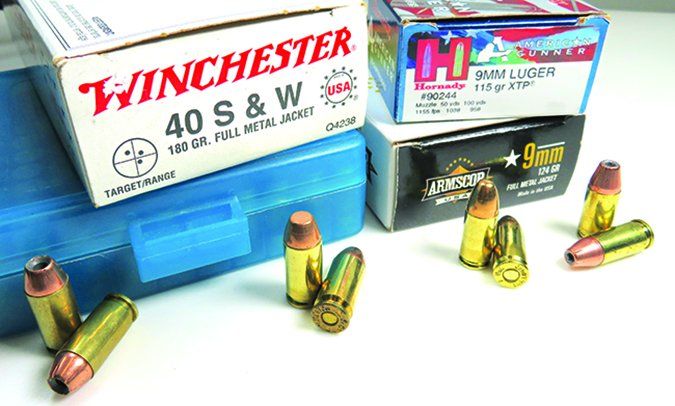
For accuracy testing we benched all three pistols in their paired calibers and fired at targets set at 25 yards. We performed speed drills at 10 yards, firing a magazine as fast as we could while still keeping hits in an 8-inch-diameter-or-smaller target. During close range work, we also performed a variety of magazine reloads and tactical reloads.
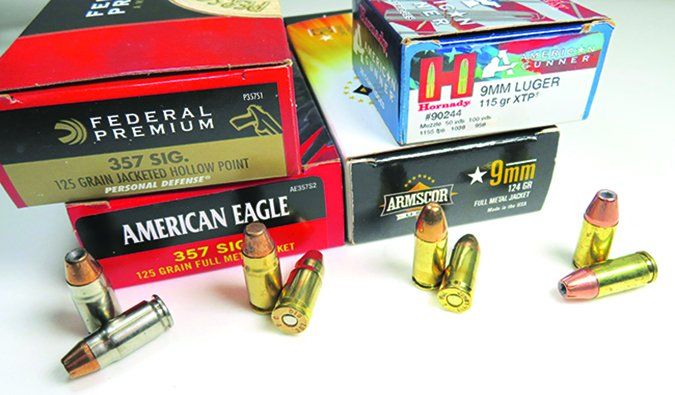
Overall, we found a lot to like with the conversion kits, and in the case of the Glock, you could be firing 9mm out of a 40 S&W Glock for less than $200. The cost of a new Glock pistol in a separate chambering is nearly three times that amount. We also discovered that swapping calibers poses point-of-impact issues with the Glock, but not with the RIA.
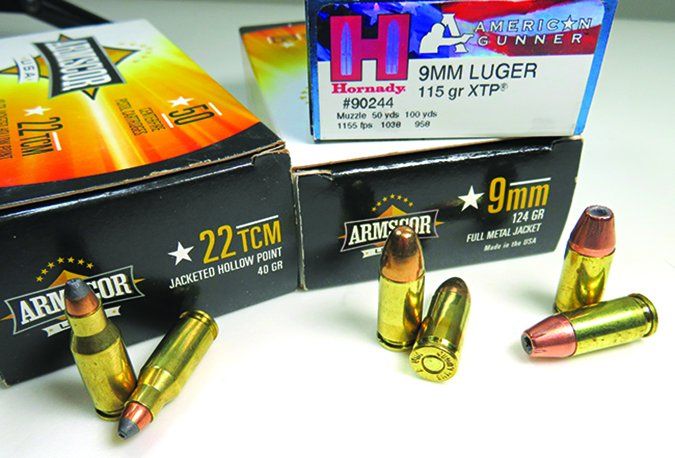
The SIG, set up with separate slide assemblies and magazines, was the best choice because there were no point-of-impact issues. The RIA had us very happy in 9mm, but in 22 TCM, we had numerous failures to eject 22 TCM cases — a no go, in our opinion. Here are the details.
Glock G35 Gen3 40 S&W, $560
Double Diamond Threaded Barrel, $160
Magpul PMAG 27 GL9, $22
GUN TESTS GRADE: A (40 S&W), A- (9mm)
The G35 in 40 S&W is a good competition pistol. Changing to 9mm makes it more versatile and more affordable to shoot, even though the point of impact changes every barrel change.
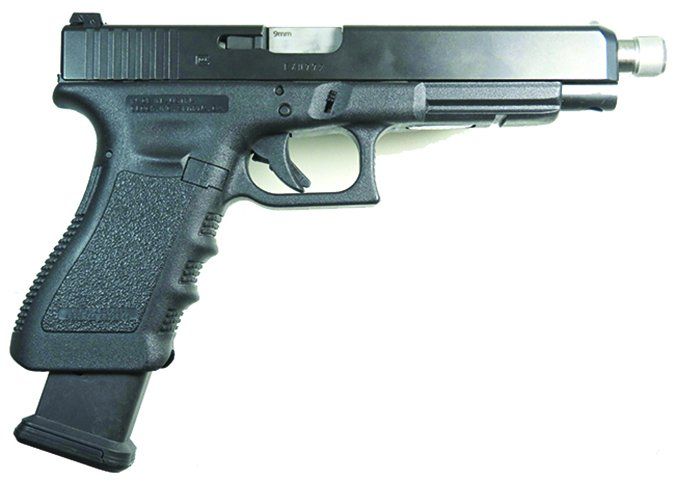
| ACTION | Locked breech, striker-fire, semi-auto |
| OVERALL LENGTH | 8.6 in. |
| OVERALL HEIGHT | 5.1 in. |
| MAX WIDTH | 1.5 in. |
| WEIGHT UNLOADED | 27.1 oz. |
| WEIGHT LOADED | 36 oz. |
| BARREL | 5.3 in., hexagonal rifling; 1:9.84 RH twist |
| CAPACITY | 15+1 (40 S&W), 27+1 (9mm) |
| SLIDE | Matte black steel |
| FRAME | Matte black steel |
| FRAME FRONT STRAP HEIGHT | 2.6 in. |
| FRAME BACK STRAP HEIGHT | 3.5 in. |
| GRIPS | Textured polymer |
| GRIP THICKNESS (max) | 1.4 in. |
| GRIP CIRCUMFERENCE (max) | 6.2 in. |
| SIGHTS | Front fixed, rear adjustable |
| SIGHT RADIUS | 7.55 in. |
| TRIGGER PULL WEIGHT | 5 lbs. |
| TRIGGER SPAN | 2.8 in. |
| SLIDE-RETRACTION EFFORT | 17 lbs. |
| MAGAZINES | 2; polymer, double stack |
| SAFETY | Trigger lever |
| WARRANTY | 1 year |
| MADE IN | USA |
| WEBSITE | US.Glock.com |
One team member had a G35 Gen3 on hand, having won it at a GSSF match. We tested this pistol in the past and given it a high grade. As an action-shooting competition pistol, the G35 offers plenty of power — it makes high power factor in 40 S&W — has a consistent trigger, adjustable sights, longer sight radius, and oversized controls. It took on average about 17 pounds of effort to rack the slide. We ran Winchester white-box factory ammo loaded with a 180-grain JHP bullets through it and were served with 2.55-inch groups at 25 yards.
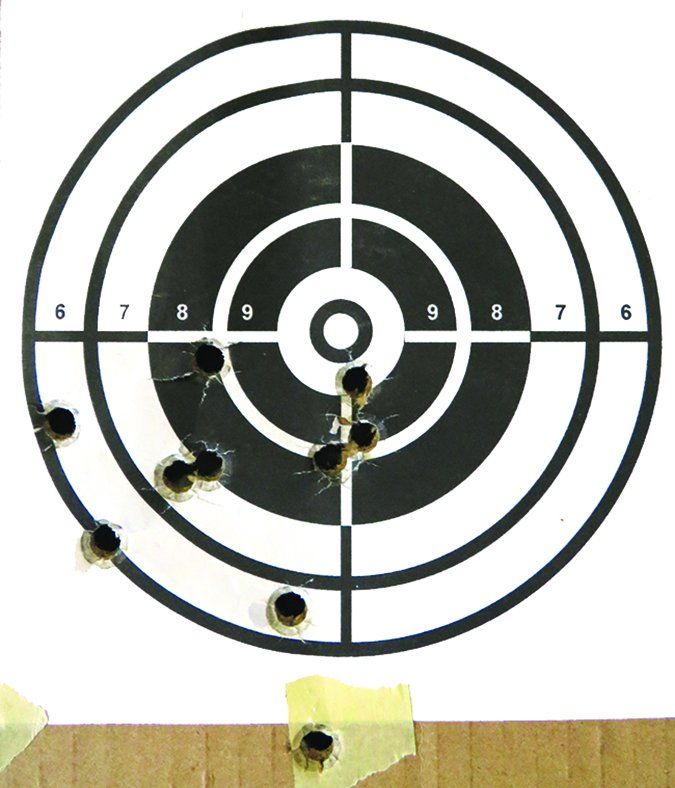
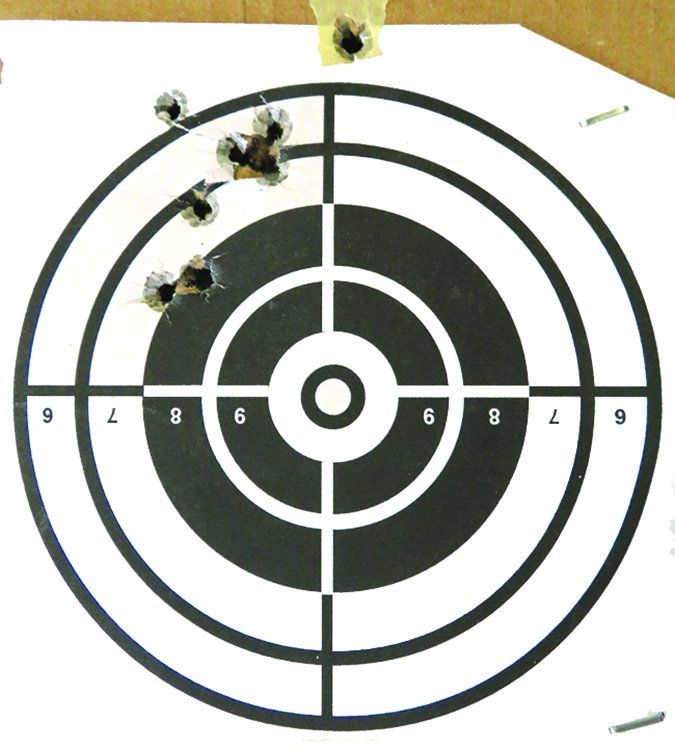
We liked how the G35 performed in 40 S&W. The 40 S&W is a snappy caliber that can be difficult to control in a smaller pistol, but with the G35 we felt we could easily handle the recoil. Converting the G35 to 9mm could create a more cost-effective training pistol that also used a milder-recoiling round. The G34, which is Glock’s 9mm equivalent to the G35, is very popular in action shooting competitions, and, in essence, we would be recreating the G34 pistol. That meant we would need a 9mm barrel and a 9mm magazine.
You cannot simply take a G34 barrel and drop it into a G35. It won’t work. The breech block is cut differently, and it will not mate up with the slide. The outside diameter of the 9mm factory barrel is smaller than the muzzle hole in slide. The outside diameter of the 40 S&W barrel is much larger than a factory 9mm barrel. A conversion barrel needs to have the basic outside dimensions of the host barrel to operate. There are numerous manufacturers of Glock caliber-conversion barrels, and we chose the Double Diamond model manufactured for Glockstore.com. This barrel is available in a variety of finishes and with a threaded or non-threaded barrel. We chose the stainless finish to differentiate it from the stock 40 S&W barrel, and we opted for a threaded muzzle so we could use a muzzle device like a compensator or a suppressor. The Double Diamond is a match-grade replacement barrel manufactured from 416 stainless steel forging and uses standard groove and land rifling. This barrel also offers full chamber support and holds a tighter tolerance than the factory Glock barrel. If we wanted to shoot lead bullets, we have that option with the Double Diamond barrel. Of course, it shoots plated and jacketed bullets, too.
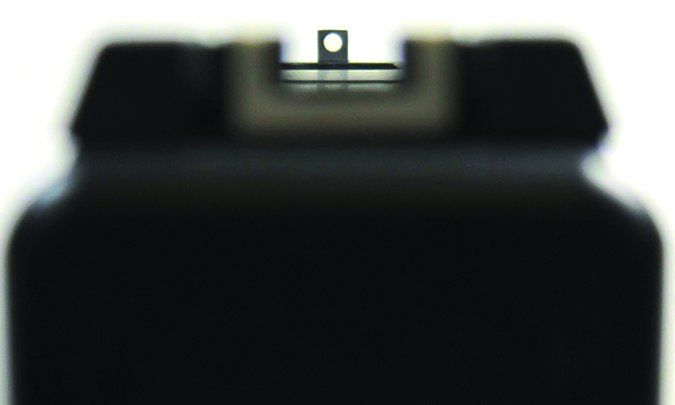
We noticed the Double Diamond conversion barrel had a thicker wall than a factory Glock 9mm barrel. It dropped into the G35 slide and fit perfectly. You can use the factory 40 S&W recoil rod guide assembly and we did, but thought we might run into issues with mild 9mm ammo not being able to cycle the slide properly.
Because factory Glock 9mm and 40 S&W magazines have similar outside dimensions but different feed lips, you could, in a pinch, run a factory 40 S&W magazine with 9mm ammo. We don’t recommend it, however, because the 9mm rounds in the 40 S&W will not feed reliably. You may get lucky and all rounds will fire without issue, but we can guarantee you will have reliability issues at some point. Our solution was a 9mm dedicated magazine. You could use a factory Glock 9mm magazine in the 40 S&W receiver, which we did because some testers had plenty of 9mm Glock magazine available. We also chose a Magpul PMAG 27 GL9 magazine. This is a polymer-body magazine with a 27-round capacity. When inserted, the Magpul magazine extends from the butt of the pistol and is designed to meet the overall length requirements for a 170mm competition magazine in certain competition shooting disciplines. Unlike the Glock factory magazines, the Magpul uses polymer feed lips. The Magpul magazine also incorporates a controlled-tilt follower and stainless-steel spring. The floor plate is easily removed for cleaning and has ridged edges for better grip. There are indicator holes built into the body to determine remaining round count. The Magpul also drops free loaded or unloaded.
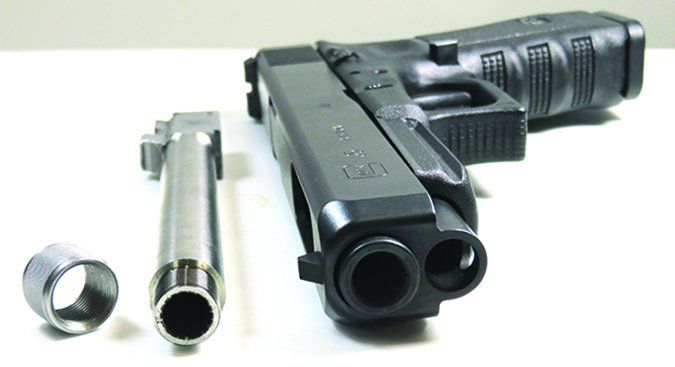
At 25 yards we fired the G35 with the 9mm Double Diamond barrel for accuracy and found it to be quite acceptable for an action-shooting pistol. Our best five-shot group was with Hornady American Gunner loaded with 115-grain XTP ammo that measured 2.09 inches. We quickly noticed a difference in the recoil between the calibers and that the G35 shot high with 9mm ammo when using the same point of aim. This can be a compromise when only swapping barrels to change calibers. Since the sights on the G35 were adjusted for our 40 S&W 155-grain handload, we knew we would have to adjust our point of aim. Not a show stopper by any means, just something to keep in mind.
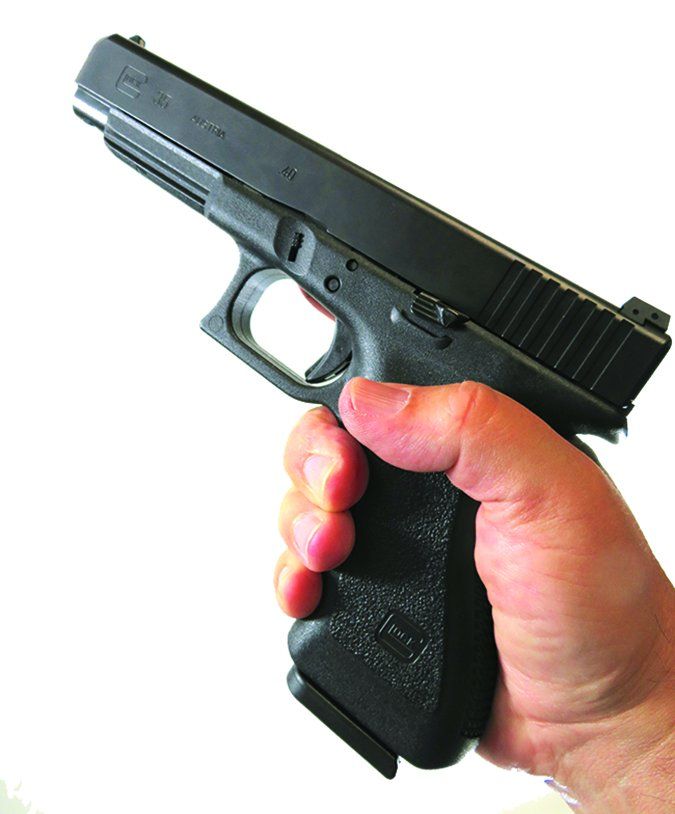
In close-range shooting at 10 yards and using the same point of aim, we were able to shoot groups that showed the difference between the two calibers. We liked how the G35 performed in 9mm and just adjusted our point of aim when shooting 9mm and ran the G35 hard to see if we could trip it up. No problemo. The Magpul was as boringly reliable as the Glock, even after we dropped the magazine loaded and unloaded on cement deck.
Our Team Said: The Glock Double Diamond caliber conversion was the least-expensive caliber-conversion option of the three pistols tested. It proved to be reliable and consistent. If we wanted a caliber conversion for competition training, we’d opt for a complete slide assembly and zero the sights to the same point of aim. If we wanted to shoot inexpensive 9mm ammo through a G35 without spending a lot, we opt just for the barrel. The Magpul magazine was what we expected from Magpul — durable and reliable.
Rock Island Armory TCM TAC Ultra MS HC No. 51943 9mm Luger/22 TCM, $960
GUN TESTS GRADE: A (9mm), F (22 TCM)
The TCM TAC Ultra is an excellent Commander-size double-stack magazine 1911 platform when chambered in 9mm. In 22 TCM, we experienced numerous failures to eject.
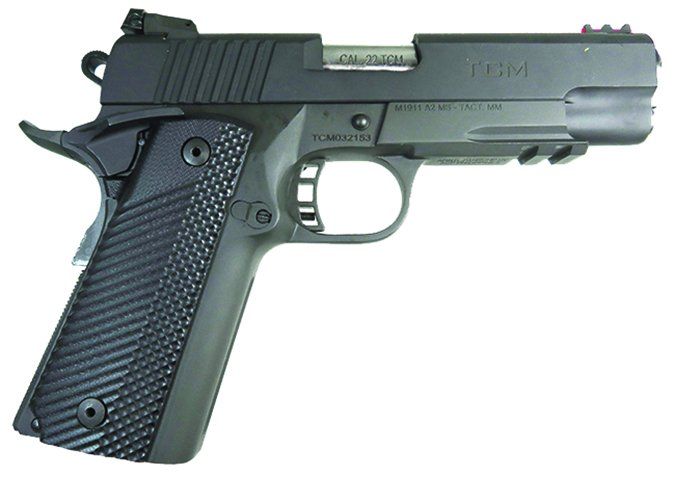
| ACTION | Locked breech, single action, semi-auto |
| OVERALL LENGTH | 8 in. |
| OVERALL HEIGHT | 5.5 in. |
| MAX WIDTH | 1.5 in. |
| WEIGHT UNLOADED | 41 oz. |
| WEIGHT LOADED | 47 oz. |
| BARREL | 4.25 in. |
| CAPACITY | 17+1 |
| SLIDE | Parkerized steel |
| FRAME | Parkerized steel |
| FRAME FRONT STRAP HEIGHT | 2.6 in. |
| FRAME BACK STRAP HEIGHT | 3.2 in. |
| GRIPS | Textured black G10 |
| GRIP THICKNESS (max) | 1.4 in. |
| GRIP CIRCUMFERENCE (max) | 5.6 in. |
| SIGHTS | Front dovetail fiber optic, rear adjustable |
| TRIGGER PULL WEIGHT | 3 lbs. |
| TRIGGER SPAN | 2.5 in. |
| SLIDE-RETRACTION EFFORT | 17 lbs. (22 TCM), 15 lbs. (22 TCM) |
| MAGAZINES | 2; steel, double stack |
| SAFETIES | Rear frame lever; beavertail grip |
| WARRANTY | Limited lifetime |
| MADE IN | Philippines |
| WEBSITE | Armscor.com |
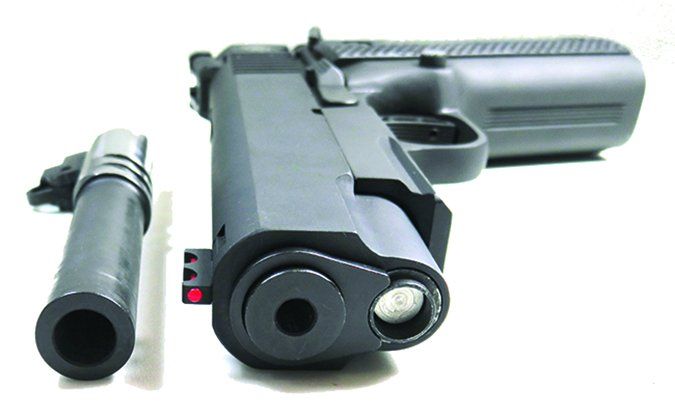
We tested the RIA TAC caliber conversion a few years ago and gave the 22 TCM caliber a high grade while the 9mm conversion had a lower grade due to failures to feed JHP ammo. This time around the situation flip-flopped. We first ran the RIA with 9mm ammo and found we really liked this pistol. The TAC uses a 1911-style Commander-size platform reconfigured to accept a double-stack magazine. The girth of the grip was comfortable to grasp even for users with small hands. The front grip strap is also serrated for a surer grip. This TAC wore an all-business, nothing-fancy, Parkerized finish that was well executed. The grips are G10 composite with contrasting textures and offer better fit and adhesion than the grips we tested last go around. The thumb safety gave us confidence and the trigger was excellent, in our opinion. It broke at a crisp 3 pounds on average. The rounded hammer has a serrated texture, so cocking the pistol was easy with no slipping. The beavertail grip safety was easy to engage, even if our grip was not perfect from a draw. The mainspring housing was straight and it offered a checkered finish for gripping. The slide serrations at the rear are coarse, and the slide took 17 pounds to retract when set up in 9mm and 15 pounds in 22 TCM. This pistol was easy to operate.
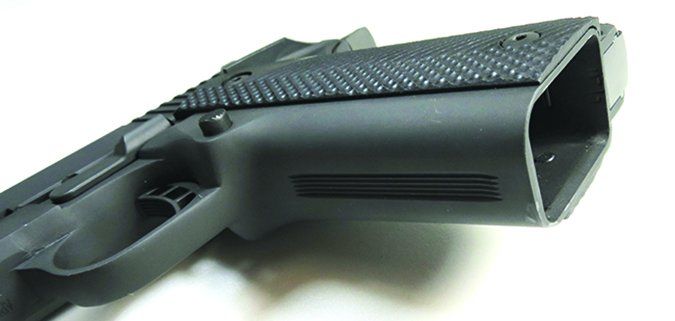
Sights consisted of an adjustable rear sight and a fiber optic dovetailed into the slide. The fiber optic is well suited for action-pistol shooting and defense situations. They are not precision sights by any means. With the RIA, the red fiber optic showed well on dark targets, but the bottom edge of the red dot is obscured by the rear sight when making the top edge of front sight flush with the top edges of the rear sight, as you would when precision target shooting. The receiver incorporates a Picatinny-style rail to mount a tactical light or laser.
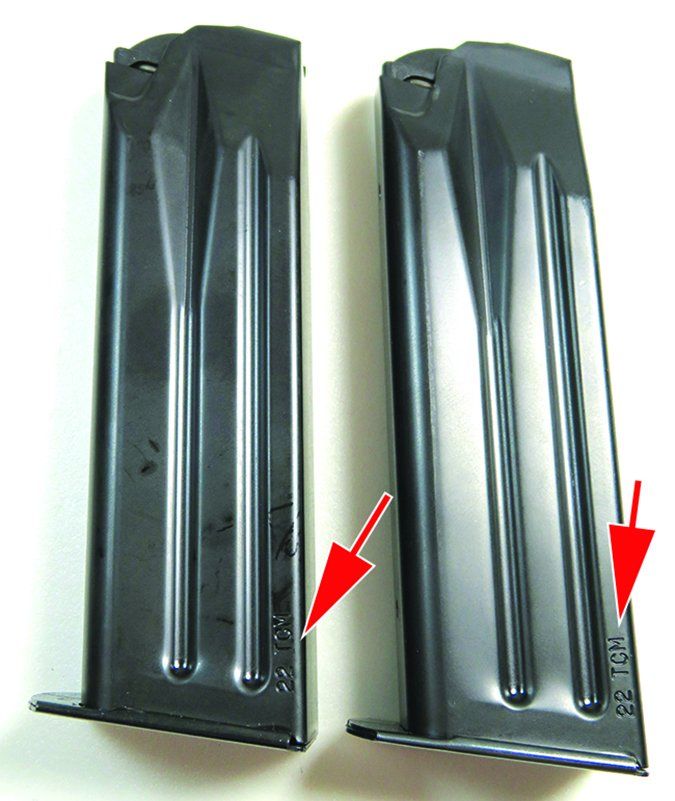
We really liked the RIA in 9mm. This is a pistol that many shooters picked up off the bench and fired it as if they had owned and trained with it for years. The accuracy we achieved with Armscor 124-grain FMJ was 1.95 inches and with Hornady American Gunner 115-grain XTP was 1.50 inches, which we attribute to the crisp trigger.
Packaged in the hard case is an extra barrel chambered in 22 TCM and a recoil spring. We would have liked the recoil springs colored coded, as they were soon mixed up during initial handling of the pistol and conversion kit. The 22 TCM spring is the thicker and heavier spring. To convert calibers is as easy as field stripping a Government-style 1911, swapping barrels and recoil spring, and re-assembling. The RIA was easy to tear down and did not have much slide/receiver wiggle, a sure sign the pistol could be an accurate shooter. Also included in the hard case were two steel-body magazines that are compatible with both 9mm and 22 TCM cartridges.
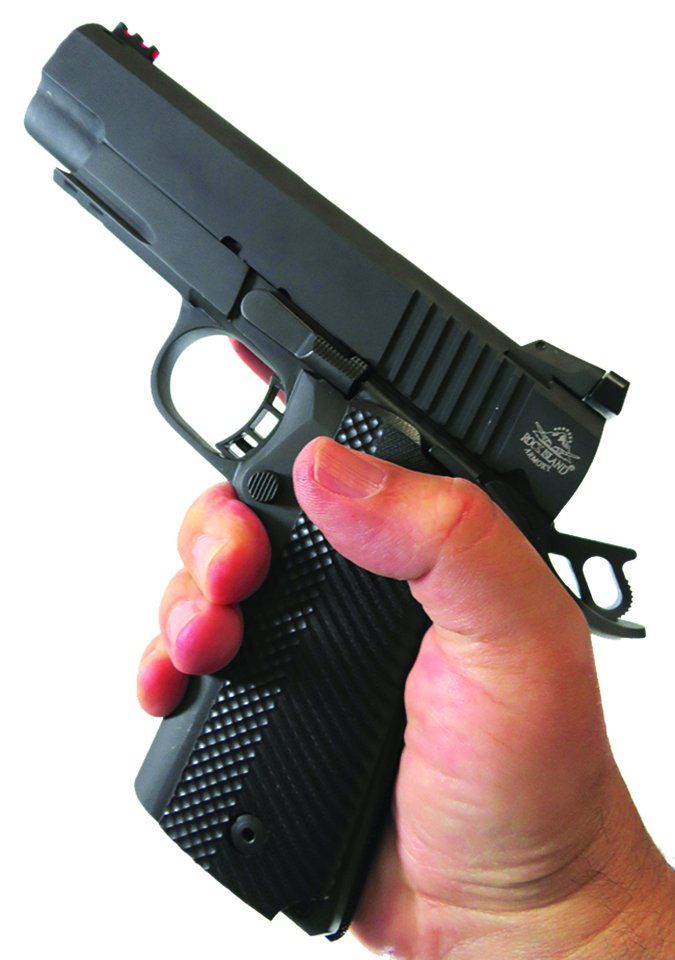
The 22 TCM cartridge is similar to the 5.7x28mm round used in the FN FiveseveN pistol, a small-caliber high-velocity round that offers little recoil and is designed for defense. Introduced in 2012, the 22 TCM uses a 5.56 NATO case cut down and resized to accept a 22-caliber bullet. Only Armscor manufactures 22 TCM cartridges, so finding ammo easily at the local gun shop might be a problem. If you have access to the internet, 22 TCM is easy to find and order online. When we chronographed the round, it clocked at 1924 fps.
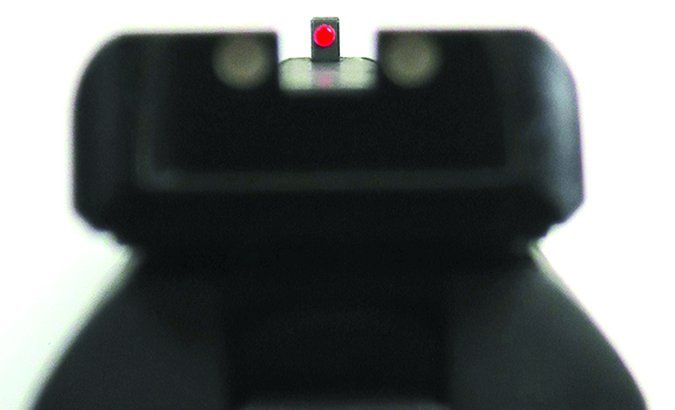
We loaded up the two magazines with 22 TCM cartridges and discovered that this pistol is a fire-breathing round that is loud, but offered very little recoil. Surprisingly, the 22 TCM also had nearly the same point of aim and point of impact as the 9mm rounds we tested. No need to change our point of aim as we were required to do with the Glock G35 using the 9mm conversion barrel. Accuracy with the 22 TCM was good. We were intrigued to continue when we experienced issues. After the first full magazine, we noticed the RIA would not eject empty 22 TCM cases. We needed to work the slide a few times for the extractor to catch the rim of the cartridge and eject it. These failures to eject happened enough that we stopped wasting our time with the 22 TCM. We converted it back to 9mm and burned through the rest of the test ammo.
Back in the shop we torn down the RIA slide to examine the extractor and found that it was fine.
Our Team Said: We would buy the RIA in 9mm in a heartbeat. Compared to other double-stack 9mm 1911 pistols, the RIA was a bargain, yet it performed like a premium-priced pistol. But the 22 TCM conversion simply wouldn’t run well enough.
SIG Sauer P226 Nitron No. E26R-9-BSS 9mm Luger, $1087
SIG Sauer Caliber X-Change Kit 357 SIG, $370
GUN TESTS GRADE: A (357 SIG), A (9mm)
There is a reason the P226 is an iconic pistol. Although pricey, the separate slide assembly ensures point of aim with each cartridge. This is Our Pick.
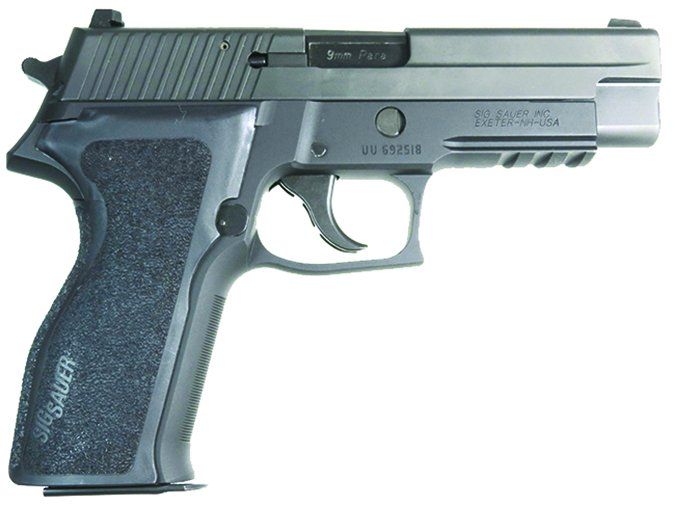
| ACTION | Locked breech, DA/SA, semi-auto |
| OVERALL LENGTH | 7.7 in. |
| OVERALL HEIGHT | 5.5 in. |
| MAX WIDTH | 1.5 in. |
| WEIGHT UNLOADED | 34 oz. |
| WEIGHT LOADED | 40 oz. |
| BARREL | 5 in. |
| CAPACITY | 15+1 (9mm), 12+1 (357 SIG) |
| SLIDE | Nitron-finished stainless steel |
| FRAME | Nitron-finished alloy |
| FRAME FRONT STRAP HEIGHT | 2.5 in. |
| FRAME BACK STRAP HEIGHT | 3.3 in. |
| GRIPS | Textured polymer |
| GRIP THICKNESS (max) | 1.3 in. |
| GRIP CIRCUMFERENCE (max) | 5.6 in. |
| SIGHTS | SIGLite night sights 3-dot, fixed front and rear |
| TRIGGER PULL WEIGHT (DA) | 9.1 lbs. |
| TRIGGER PULL WEIGHT (SA) | 4.9 lbs. |
| TRIGGER SPAN (DA) | 2.9 in. |
| TRIGGER SPAN (SA) | 2.6 in. |
| SLIDE-RETRACTION EFFORT | 17 lbs. (357 SIG) |
| MAGAZINES | 2; steel, double stack |
| SAFETY | Decocking lever |
| WARRANTY | Lifetime |
| MADE IN | USA |
| WEBSITE | SIGSauer.com |
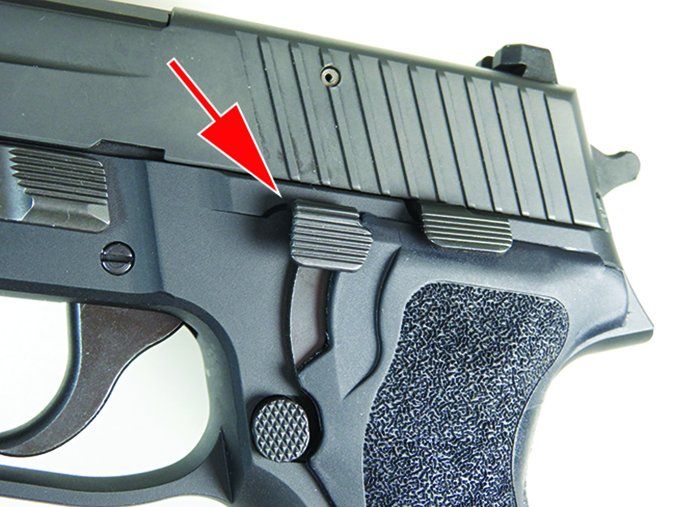
There is a reason the P226 is an iconic and popular pistol worldwide. Our sample was a Nitron model with the E2 one-piece grip designed to have less girth than pervious P226 models. Small-handed testers liked the textured E2 grip circumference, the angle of the grip, and the texture. The P226 wore a well-executed matte-black Nitron finish, and the controls were very familiar to those testers familiar with SIG’s classic DA/SA pistols.
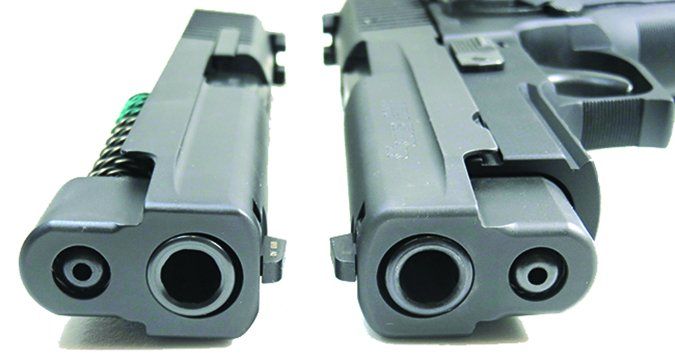
On the left side of the receiver is a decocking lever, which is easy for shooters with average-to-large hand sizes to operate effectively with the shooting hand. Shooters with smaller hands need to reposition the grip or use the thumb of their support hand to operate the decocking lever. Rotating the lever decocks the P226 from full cock to half cock and changes the trigger mode from SA to DA. The hammer was serrated, so there was no slipping when thumbing back the hammer to fire in SA mode. Since the P226 uses a double-action/single-action trigger, managing the trigger is quite different than the striker-fire Glock and the single-action trigger of the RIA 1911. Some testers like the fact the DA/SA trigger can be preloaded with finger pressure, much like a DA/SA revolver trigger, and then followed through — or not — to fire the pistol when on target.
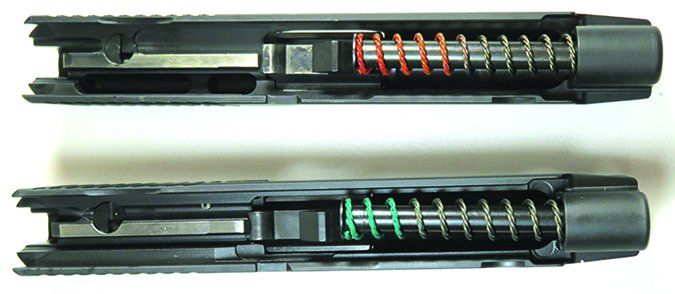
The P226 uses a 3-dot sighting system that, in our opinion, is better for more precision shooting due to the fact the top edge of the front sight can be made flush with the top edges of the rear sight without the dot in the front sight being covered or obscured by the rear sight. We liked these sights.
In double-action mode, the trigger pull averaged 9.1 pounds. The trigger pull was smooth and consistent. In SA mode, the trigger had a bit of take up but broke cleanly at 4.9 pounds. We had one tester bench the P226 at 10 yards and placed nearly a full magazine in one ragged hole with both 9mm ammo brands tested. At 25 yards, the P226 liked both the Armscor 124-grain FMJ and Hornady American Gunner 115-grain XTP hollow-point loads. We were able to produce 1.72-inch and 1.75-inch groups with those brands, respectively.
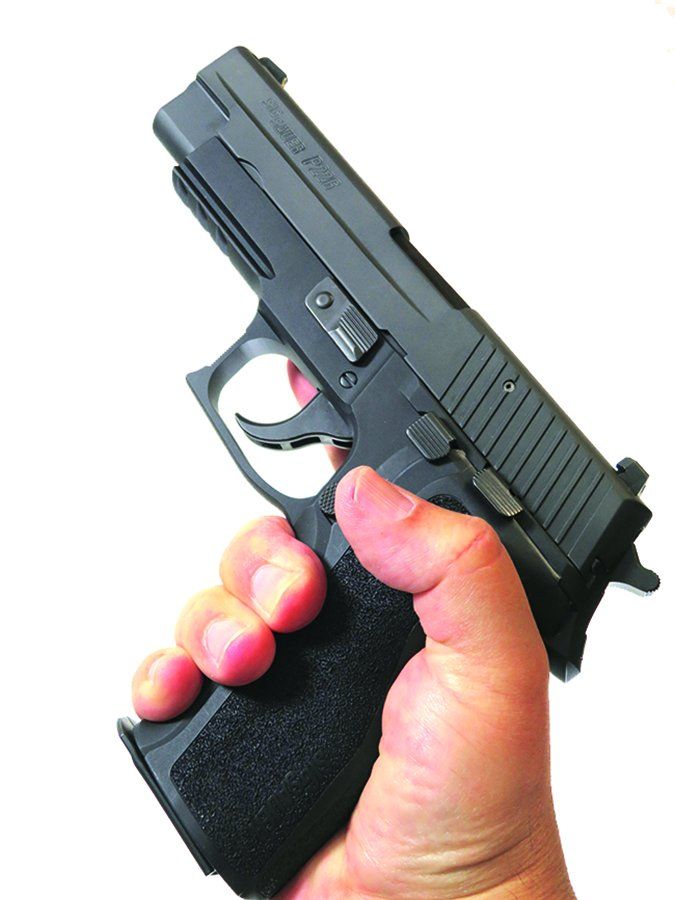
SIG offers a Caliber X-Change Kit for the P226, so we procured a kit in 357 SIG with the intent of increasing the power over the 9mm. The kit consists of a slide assembly and steel body and a double stack magazine compatible with 357 SIG ammo in a hard case. The kit was expensive compared to the other options, but we soon grew to appreciate the separate slide and magazine.
If we had a 40 S&W SIG pistol on hand, we could have just swapped out a 357 SIG barrel and used the 40 S&W magazine, since the 40 S&W and 357 SIG share the same magazine. Going from the smaller caliber to larger caliber, with the SIG requires a slide built to withstand the pressure of the more powerful 357 SIG caliber.
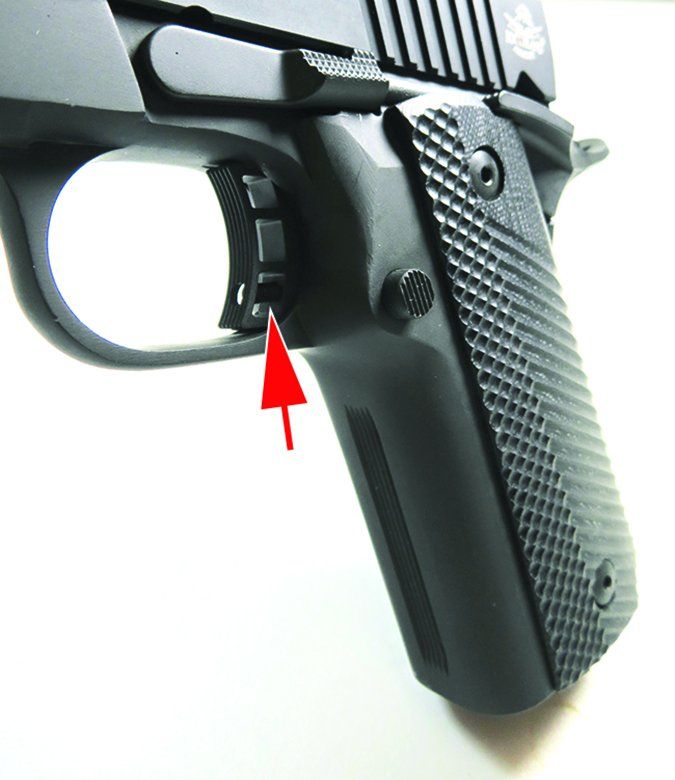
The 357 SIG cartridge was introduced in 1994 and is unique in that is it a bottleneck cartridge, similar to the 22 TCM but with less downsizing. The idea behind the 357 SIG was SIG Sauer and Federal Premium ammunition necked down the 10mm case to fit a .357-inch bullet and mimic the velocity and energy of a 125-grain 357 Magnum revolver cartridge in a smaller, semi-automatic pistol platform. Recoil is about the same as a 40 S&W, but the 357 SIG has noticeably higher muzzle blast. The round was adopted by numerous law-enforcement agencies, with most of those agencies having good results with power, penetration, and compact nature of the firearm. The popularity of the 357 SIG was never stellar and the round has declined more rapidly in popularity than the 40 S&W in LE circles, probably due to the cost of the round and the better ballistics and higher magazine capacity in recent 9mm ammo loadings.
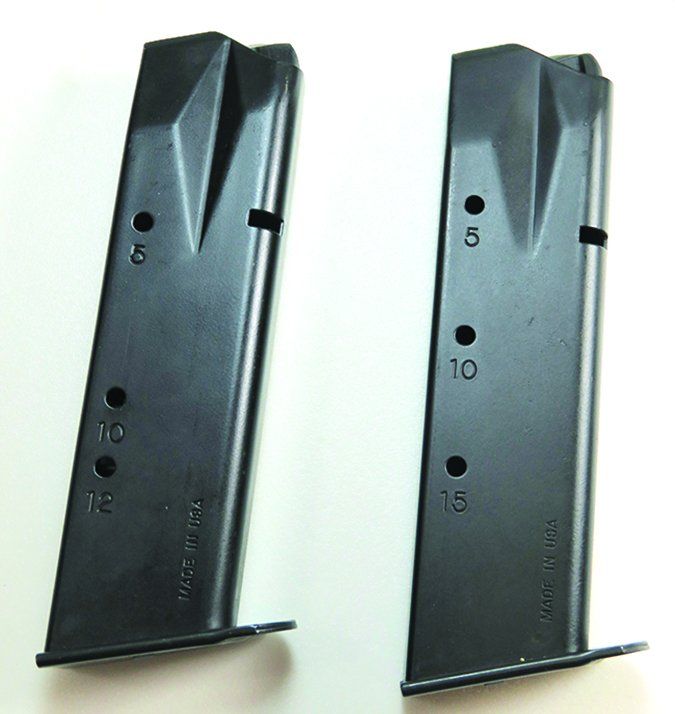
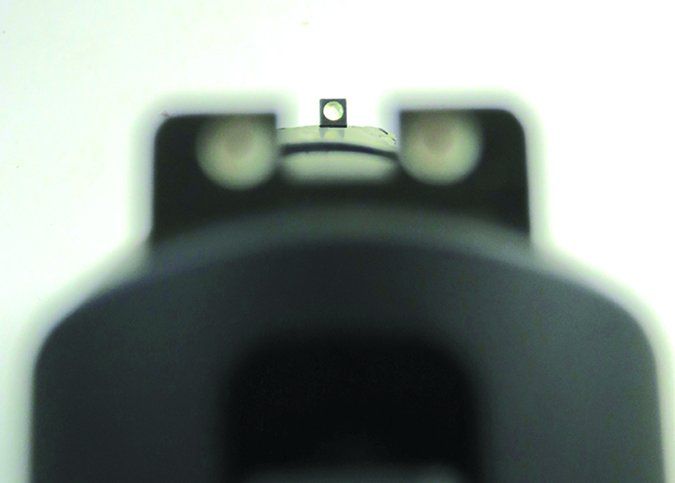
To exchange calibers in the SIG, just field strip the P226 and reassemble with the Caliber X-Change slide assembly for 357 SIG. The slide assembly is complete with internal parts such as the firing pin mechanism, extractor, recoil spring, barrel, slide and sights. It is also clearly marked on the breech block of the barrel the caliber of the barrel. We did note that swapping barrels and exchanging calibers can be confusing. We had a tester accidentally load 40 S&W in the 357 SIG magazine and try to chamber the 40 S&W round in the 357 SIG barrel. Of course that did not happen, but remember to keep ammo separate to lessen confusion.
The P226 outfitted with the 357 SIG slide assembly performed without fail. The 357 SIG caliber has noticeably more recoil and muzzle blast than the 9mm, which we expected. We liked the fact we could zero the sights to the 357 SIG load.
Our Team Said: The Caliber X-Change kit efficiently changed the P226 in 9mm to 357 SIG. We liked the fact the kit had all the components assembled, so all that was required was swapped slides and magazines. Though this option was the most costly, we thought it was also the most effective since the sights and recoil spring were specifically designed for the 357 SIG.
Written and photographed by Robert Sadowski, using evaluations from Gun Tests team testers.































